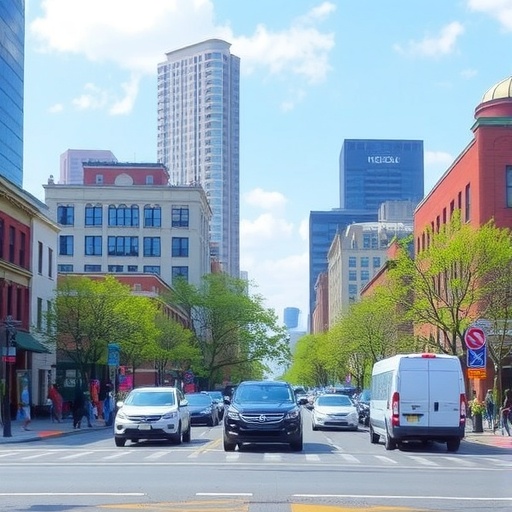SUN: Study links Port of Baltimore coal terminal to Curtis Bay air pollution – WBFF

Report on Industrial Air Pollution in Curtis Bay and its Conflict with Sustainable Development Goals
Executive Summary
A community-driven study conducted by researchers from the Johns Hopkins Bloomberg School of Public Health has established a direct correlation between bulldozer operations at the CSX Corp. coal terminal and significant increases in air pollution in the adjacent Curtis Bay neighborhood of Baltimore. The research, published in the “Air Quality, Atmosphere & Health” journal, provides empirical evidence that industrial activities are a primary contributor to airborne pollutants, posing substantial risks to public health and undermining progress toward key United Nations Sustainable Development Goals (SDGs).
Key Findings and Public Health Implications
The year-long study (July 2022 – July 2023) utilized air pollutant monitors and observational cameras to track industrial activity and its environmental impact. The data revealed a clear pattern:
- Levels of black carbon and other fine particulate matter (PM2.5) rose sharply during periods of visible bulldozer activity involving coal manipulation.
- Pollutant concentrations were highest when prevailing winds directed dust from the terminal towards the residential community.
- These findings scientifically validate long-standing complaints from Curtis Bay residents regarding the accumulation of black dust on homes and throughout the neighborhood.
This directly impacts SDG 3: Good Health and Well-being, as exposure to fine particulate matter is linked to severe health conditions, including respiratory illnesses, cardiovascular disease, and other serious health risks, particularly in a community already burdened by industrial operations.
Challenges to Sustainable Cities and Environmental Justice
The persistent air pollution from the coal terminal presents a significant barrier to achieving SDG 11: Sustainable Cities and Communities. This goal aims to make cities and human settlements inclusive, safe, resilient, and sustainable. The situation in Curtis Bay highlights a critical failure in reducing the adverse per capita environmental impact of cities, with a specific deficiency in managing air quality in residential zones.
Furthermore, the issue is a matter of environmental justice, central to SDG 16: Peace, Justice and Strong Institutions. The study, described as “community-driven,” empowers residents with scientific data to advocate for their right to a clean and healthy environment, demanding accountability from industrial operators and responsiveness from regulatory institutions.
Alignment with Global Sustainable Development Agenda
The study’s conclusions have broad implications across multiple Sustainable Development Goals:
- SDG 3 (Good Health and Well-being): The terminal’s operations are identified as a significant driver of air pollution, directly threatening the health and well-being of the Curtis Bay community.
- SDG 11 (Sustainable Cities and Communities): The ongoing pollution undermines the goal of creating safe and healthy urban environments, disproportionately affecting a community burdened by heavy industry.
- SDG 12 (Responsible Consumption and Production): The findings call into question the sustainable practices of corporate entities like CSX Corp., emphasizing the need for industries to manage and mitigate their environmental externalities responsibly.
- SDG 17 (Partnerships for the Goals): The collaboration between Curtis Bay residents and Johns Hopkins researchers exemplifies a powerful partnership using science and community engagement to address local challenges and advocate for sustainable development.
Conclusion
The research provides definitive evidence linking the CSX Curtis Bay Piers terminal to harmful air pollution, confirming the lived experiences of the local community. This case underscores the urgent need for industrial operators to adopt cleaner practices and for regulatory bodies to enforce standards that protect public health. Addressing this issue is critical not only for the residents of Curtis Bay but also for fulfilling the broader commitments to health, environmental justice, and sustainability as outlined in the Sustainable Development Goals.
Analysis of Sustainable Development Goals in the Article
1. Which SDGs are addressed or connected to the issues highlighted in the article?
-
SDG 3: Good Health and Well-being
- The article directly connects air pollution from the coal terminal to human health. It states that the pollutants measured, such as black carbon and fine particulate matter, are “linked to serious health risks.” This highlights the goal of ensuring healthy lives and promoting well-being for the residents of the Curtis Bay neighborhood.
-
SDG 11: Sustainable Cities and Communities
- The issue is centered on an urban residential area, the “Curtis Bay neighborhood,” which is negatively affected by industrial operations within the city of Baltimore. The article discusses the “spikes in air pollution” and the accumulation of “black dust” in the community, which directly relates to the goal of making cities inclusive, safe, resilient, and sustainable by managing their environmental impact.
-
SDG 12: Responsible Consumption and Production
- The pollution originates from industrial activity at the “CSX Corp.’s Curtis Bay Piers terminal.” The release of coal dust due to bulldozer operations represents a failure in the environmentally sound management of production processes. This connects to the goal of ensuring sustainable consumption and production patterns by minimizing the release of pollutants into the environment.
2. What specific targets under those SDGs can be identified based on the article’s content?
-
Target 3.9: By 2030, substantially reduce the number of deaths and illnesses from hazardous chemicals and air, water and soil pollution and contamination.
- The article’s focus on “pollutants linked to serious health risks” and the community’s observation of “black dust” from coal operations directly aligns with this target’s aim to reduce illness from air pollution and hazardous materials.
-
Target 11.6: By 2030, reduce the adverse per capita environmental impact of cities, including by paying special attention to air quality and municipal and other waste management.
- The study’s finding that the coal terminal is a “significant contributor to air pollution in the surrounding residential area” is a clear example of an adverse environmental impact within a city. The entire article is dedicated to the issue of poor air quality in a specific urban neighborhood, making this target highly relevant.
-
Target 12.4: By 2020, achieve the environmentally sound management of chemicals and all wastes throughout their life cycle… and significantly reduce their release to air, water and soil in order to minimize their adverse impacts on human health and the environment.
- The article describes how bulldozer operations push coal, leading to the release of coal dust (“black dust”) into the air. This release is a direct consequence of the terminal’s operational process and represents a failure to manage waste (dust) in an environmentally sound way, thereby impacting human health.
3. Are there any indicators mentioned or implied in the article that can be used to measure progress towards the identified targets?
-
Indicator 11.6.2: Annual mean levels of fine particulate matter (e.g. PM2.5 and PM10) in cities (population weighted).
- This indicator is directly addressed. The article explicitly states that researchers set up “air pollutant monitors” and that the “data revealed that levels of black carbon and other fine particulate matter… rose sharply.” The measurement of these specific pollutants is the core methodology used to track progress for this indicator.
-
Indicator 3.9.1: Mortality rate attributed to household and ambient air pollution.
- While the article does not mention mortality rates, it directly measures the primary cause of the health risk: ambient air pollution. The study’s measurement of “black carbon and other fine particulate matter” serves as a foundational metric for assessing the health impacts described in this indicator. The presence of these pollutants is what contributes to the illnesses and potential deaths the indicator tracks.
-
Implied Indicator for Target 12.4: Measurement of pollutant release from industrial sites.
- The article implies an indicator by describing the method used to link the pollution to its source. The use of “cameras to track visible bulldozer activity” combined with data from “air pollutant monitors” serves as a direct measurement of the release of pollutants (coal dust) into the air from a specific industrial process, which is the central concern of Target 12.4.
4. Summary Table of SDGs, Targets, and Indicators
| SDGs | Targets | Indicators Identified in the Article |
|---|---|---|
| SDG 3: Good Health and Well-being | 3.9: Reduce deaths and illnesses from hazardous chemicals and air pollution. | The measurement of “levels of black carbon and other fine particulate matter” which are “linked to serious health risks” (a direct measure for Indicator 3.9.1). |
| SDG 11: Sustainable Cities and Communities | 11.6: Reduce the adverse per capita environmental impact of cities, paying special attention to air quality. | The measurement of “levels of black carbon and other fine particulate matter” in the Curtis Bay neighborhood (a direct measure for Indicator 11.6.2). |
| SDG 12: Responsible Consumption and Production | 12.4: Achieve the environmentally sound management of chemicals and all wastes to reduce their release to air. | The observation and measurement of “coal dust” being released into the air due to “bulldozer operations at a coal terminal.” |
Source: foxbaltimore.com

What is Your Reaction?
 Like
0
Like
0
 Dislike
0
Dislike
0
 Love
0
Love
0
 Funny
0
Funny
0
 Angry
0
Angry
0
 Sad
0
Sad
0
 Wow
0
Wow
0













































































